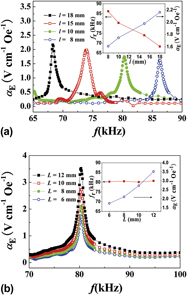Article contents
Magnetoelectric effect in a bi-rectangular structure composed of negative/positive magnetostrictive and piezoelectric flakes
Published online by Cambridge University Press: 06 September 2011
Abstract

Magnetoelectric (ME) effect has been studied in bi-rectangular structure made up of epoxy-bonded negative/positive magnetostrictive and piezoelectric flakes. The ME effect is affected by negative and positive magnetostrictive flakes. The ME voltage coefficient at resonance frequency shows a nearly constant plateau behavior with the bias magnetic field increased from 1 to 3.5 kOe. There is no interface between magnetostrictive and piezoelectric flakes required to achieve ME coupling, which provides a new choice to make ME devices.
Keywords
- Type
- Articles
- Information
- Copyright
- Copyright © Materials Research Society 2011
References
REFERENCES
- 4
- Cited by


